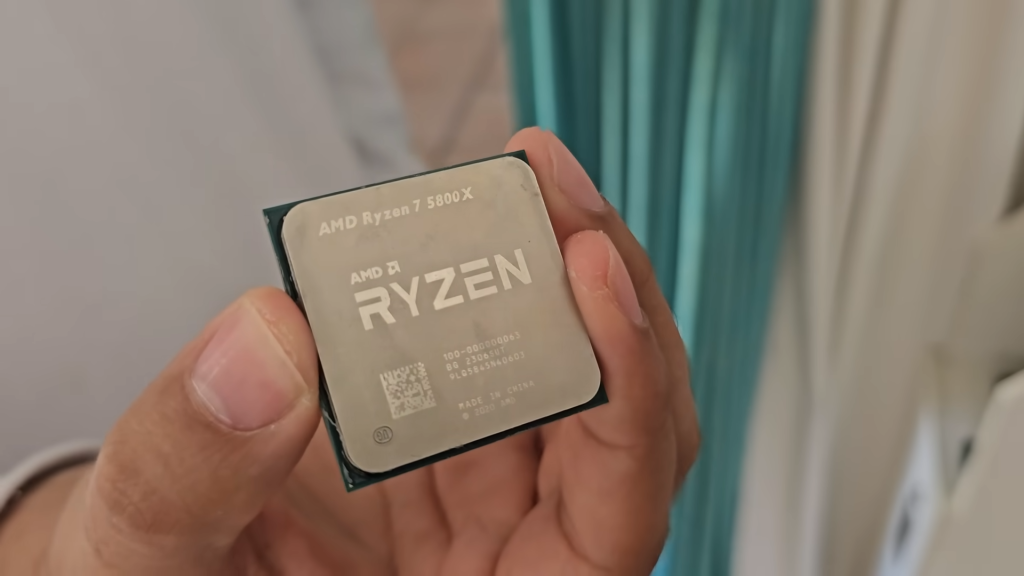In a surprising turn of events, a YouTuber has successfully revived a seemingly doomed AMD Ryzen 7 5800X processor, showcasing an impressive feat of troubleshooting in the face of a significant instability issue. The incident brings to light not only the occasional reliability concerns faced by Ryzen CPUs but also the effective techniques available for overcoming such challenges in the enthusiast community.
Uncovering the Problematic Chip
The story begins when the YouTuber, known as Tech Yes City, acquired the failing Ryzen 7 5800X from a seller who had been unable to resolve its issues even after extensive troubleshooting efforts. This particular chip had already been replaced once due to similar issues and, after just one year of use, it had completely stopped functioning.
Not one to shy away from a challenge, Tech Yes City offered the previous owner $30 for the non-functioning CPU, aiming to breathe new life into the struggling component. Initial assessments indicated multiple bent pins and general grime build-up; issues that could potentially explain the instability.
Initial Troubleshooting Steps
After cleaning the CPU and delicately bending the pins back into place, Tech Yes City conducted a series of diagnostic tests to evaluate the stability of the 5800X. The first test was a session in the BIOS, where the processor operated without crashing for 30 minutes, suggesting that the core components were likely intact.
However, the real test came when the YouTuber subjected the CPU to a rigorous 3-hour OCCT stress test. This time, the results were disheartening—the system experienced a hard crash, indicating that the CPU was indeed suffering from severe instability.
Successful Fix: Downclocking the CPU
After identifying that the CPU’s cores were most likely struggling at their high boost frequencies, Tech Yes City utilized AMD’s Precision Boost Overdrive (PBO) tools to implement a -300 MHz offset. This significant downclocking was a calculated risk aimed at stabilizing the processor’s performance.
Following these adjustments, the 5800X was put back through OCCT’s stress test, eventually passing after one hour without issues. This solution highlighted an interesting point about Ryzen CPUs: despite the speed reduction, the 5800X still delivered competitive performance compared to other models.
In fact, benchmark comparisons showed the downclocked 5800X able to outperform the Ryzen 7 5700X in several gaming scenarios. For example, in Call of Duty: Black Ops, the 5800X achieved an average of 152 FPS versus the 5700X’s 147 FPS, demonstrating that a lower clock speed doesn’t always equate to inferior performance.
Understanding CPU Degradation
The degradation of CPUs is a complex issue, and a chip like the Ryzen 7 5800X should not typically show signs of failure after just one year of use. AMD’s Ryzen processors are often praised for their longevity and reliability, especially compared to Intel’s Raptor Lake counterparts. However, instances of accelerated degradation can occur due to a variety of factors, including thermal management, voltage settings, and overall usage patterns.
As seen with this case, downclocking can serve as a temporary workaround for users facing similar problems. Prior to the introduction of firmware updates aimed at addressing stability issues in Intel’s Raptor Lake architecture, many enthusiasts resorted to similar measures when their CPUs began to exhibit instability.
According to recent observations from Tom’s Hardware, the Intel 0x12F update was pivotal in addressing long-standing instability problems, emphasizing the importance of structural fixes in the CPU ecosystem.
Community Insights and Future Implications
The successful recovery of the Ryzen 7 5800X by Tech Yes City reflects not only the DIY spirit within the PC building community but also highlights the resilience of many AMD processors. With the increasing complexity of CPU designs and their thermal management, it is not uncommon for users to encounter similar issues as their hardware ages. Techniques like downclocking may serve as a viable solution for those experiencing instability, allowing them to continue utilizing their systems effectively.
As the landscape of CPUs continues to evolve, both AMD and Intel enthusiasts must remain vigilant and adaptive to emerging challenges and solutions. This incident stands as a testament to the DIY ethos prevalent in the gaming community, where creativity and persistence often lead to innovative fixes and insightful preemptive strategies.

